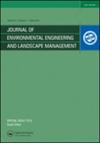QUANTITATIVE STUDY ON GHG EMISSIONS AND THE GWP INFLUENCE OF CEMETERY GREEN SPACE MAINTENANCE BASED ON LCA
IF 1.1
4区 环境科学与生态学
Q4 ENVIRONMENTAL SCIENCES
Journal of Environmental Engineering and Landscape Management
Pub Date : 2023-02-28
DOI:10.3846/jeelm.2023.18488
引用次数: 0
Abstract
Cemetery landscapes are austere and generally require maintenance. The materials and equipment used for maintenance emit greenhouse gases (GHGs). This research aimed to quantify the annual GHG emissions and global warming potential (GWP) indices of traditional and natural cemeteries for more environmentally friendly green and grey facility planning of cemetery areas. Based on life cycle assessment (LCA), in Yorkshire, UK, as an example, traditional cemeteries were found to be mostly established with landscaped cemetery facilities, and natural cemeteries were found to include mostly underground burials covered with wild plants. The average GHG emissions per hm2 in traditional cemetery maintenance (1,552.88 kg/CO2-e) were 1.8 times those in natural cemeteries (870.88 kg/CO2-e). In the cemetery plant community, the mean GHG emissions for grassland maintenance (1,867.65 kg/CO2-e) were 6.7, 2.8 and 2.3 times higher than the woodland, meadow and shrub maintenance values of 280.77, 673.03 and 821.00 kg/CO2-e, respectively. The mean GWP indexes for traditional and natural cemetery green space maintenance were 0.027 and 0.015, respectively, which were generally higher than those for urban green space maintenance (0.010). This research recommends replacing grasslands with wild meadows, reducing the size of ground cemetery facilities and limiting the application of maintenance materials (i.e., irrigation water and pesticides) to reduce the environmental impact of green space in cemeteries.基于lca的墓地绿地维护温室气体排放及GWP影响定量研究
墓地的景观十分朴素,通常需要维护。用于维护的材料和设备会排放温室气体。这项研究旨在量化传统和天然墓地的年度温室气体排放量和全球变暖潜能值(GWP)指数,以便对墓地区域进行更环保的绿色和灰色设施规划。根据生命周期评估(LCA),以英国约克郡为例,发现传统墓地大多配有景观墓地设施,而天然墓地大多包括覆盖着野生植物的地下墓地。传统墓地维护的平均每hm2 GHG排放量(1552.88 kg/CO2-e)是自然墓地的1.8倍(870.88 kg/CO2-e)。在墓地植物群落中,草地维护的平均GHG排放量(1867.65 kg/CO2-e)分别是林地、草地和灌木维护值280.77、673.03和821.00 kg/CO2-e的6.7、2.8和2.3倍。传统墓地绿地维护和自然墓地绿地维护的平均GWP指数分别为0.027和0.015,普遍高于城市绿地维护(0.010),减少地面墓地设施的规模,并限制维护材料(即灌溉水和杀虫剂)的使用,以减少墓地绿地对环境的影响。
本文章由计算机程序翻译,如有差异,请以英文原文为准。
求助全文
约1分钟内获得全文
求助全文
来源期刊
CiteScore
1.90
自引率
7.70%
发文量
41
审稿时长
>12 weeks
期刊介绍:
The Journal of Environmental Engineering and Landscape Management publishes original research about the environment with emphasis on sustainability.

 求助内容:
求助内容: 应助结果提醒方式:
应助结果提醒方式:


